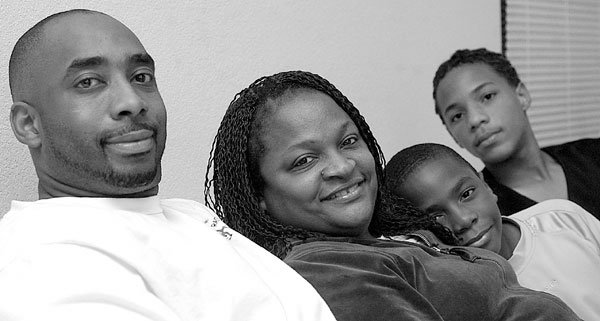Every weekday, Jim Hemeon wakes up at 5:30am and relishes the
few quiet moments he’ll have for the remainder of the day. A
half-hour later, he begins the daunting process of getting the rest
of the family up and at ’em. After an average of three tries, the
kids are awake and the mayhem ensues.
Every weekday, Jim Hemeon wakes up at 5:30am and relishes the few quiet moments he’ll have for the remainder of the day. A half-hour later, he begins the daunting process of getting the rest of the family up and at ’em. After an average of three tries, the kids are awake and the mayhem ensues.
The next hour is a flurry of Jim and his wife, Margie, making breakfast, gathering sports equipment, packing lunches and shooing everyone out the door before the clock strikes eight.
It seems things just don’t slow down for the Hemeons, who live in a quiet, welcoming west Gilroy neighborhood. Jim, in his 25th year teaching at Live Oak High School in Morgan Hill, and Margie, a nurse at Santa Teresa Kaiser, sometimes have a hard time keeping it all straight.
One of their children, Ben, went off to college this year, and the schedules of the other two, Dani and Matt, are enough to make anyone’s head spin: practices for basketball, baseball, soccer, football, swimming, softball, as well as leadership class, religious class and band practice. And, of course, daily homework, weekly church and monthly school functions.
But the family says they’d have it no other way.
“Sometimes, it’s really challenging that we’re so busy,” said Margie, scanning her eyes over a giant calendar smudged with pencil and eraser marks. “But then you take a deep breath and think, ‘Gosh, how lucky we are that our kids like doing these things.’ I wouldn’t trade it for anything. Nothing.”
More and more, the Hemeons’ hectic schedule is not the exception to the norm, but quickly becoming the rule. At every turn, parents and their children are finding more and more opportunities to get involved in something – volunteering on a committee, enrolling in the drama club or helping organize the neighborhood potluck.
Mark Milwee, pastor of First Baptist Church in Gilroy for six years, said he’s noticed a steady rise in the stress levels of many families who are being stretched in every direction possible.
“Living here in this area, it requires most families to have dual incomes just to survive,” he said. “They’re just stretched to the limit. Then you throw in children, their activities, sports and various programs, and it’s just a vicious cycle.”
Daily life certainly might seem vicious when Laura and Geno Hagiperos of Morgan Hill collapse into bed after a full day, sometimes at 1am. Geno owns a hardwood flooring company in Campbell, which his wife keeps the books for along with her part-time job as a physical education teacher at Charter Middle School. She also serves on the city’s parks and recreation commission and is president of El Toro Elementary’s home and school club.
The Hagiperos have coached Pony League baseball in Morgan Hill for nine years. Preparation for the season begins in late February, and for the four or five months following, the Hagiperos eat, sleep and breathe Pony League.
“Our lives pretty much stop,” Geno said.
Geno and Laura’s three sons each play a number of sports. Seven-year-old Ben, a student at El Toro Elementary, takes a weekly tap dancing class. Alex, 11, attends Martin Murphy Middle School and plays the trumpet, as does his older brother Nick, an eighth grader at Martin Murphy. The family also participates in weekly neighborhood Bible studies and occasionally helps coordinate games of flag football.
How do they know when it’s becoming too much?
“When we start getting snappy with each other,” Laura said, “then we know we’re getting too busy.”
A tense atmosphere at home is one indication the schedule probably is too packed, said Donna Cohen Cretcher, a family counselor in Morgan Hill. To keep the snappy comments at bay, Cretcher said establishing priorities is paramount.
“When life is crazy and you’re overwhelmed, you have to realize where your priorities are, and that helps you stay grounded,” she said. “Parents should be running the show. Unfortunately, kids’ activities tend to do that.”
Being involved isn’t a bad thing in and of itself, Cretcher said. Participating in activities both as a family and as individuals can foster new friendships and create long-lasting memories.
“Life has a lot to offer. It’s great if you have an eager outlook and everything interests you. That’s healthy; it’s a good thing,” she said.
But being so interested can become a problem when those extra commitments overshadow everything else, especially time with your family and with your spouse. Many people volunteer in the community or participate in activities because it boosts their self-esteem, but what they might not realize is keeping the family strong also will make them feel good, Cretcher said.
“I always say, how do you spell love? You spell it T-I-M-E,” Pastor Milwee said. “When families and couples are not getting time together, distance happens because they’re not able to nurture those relationships, and the relationship suffers as a consequence.”
When their children’s busy schedules begin to dominate their time alone, Jim and Margie Hemeon said they’ve learned to make an extra effort for time away.
“Sometimes it’s, ‘Hi honey, have a good day!’ in the morning, and then we don’t talk again until late that night,” Margie said. “But we just had a night out together on Saturday. We went to the movies. That was really nice.”
For Geno and Laura Hagiperos, relaxing comes in the form of going out as a family on weekends. Renting movies, snow skiing, watching sports on television, shooting hoops or playing catch are a few things the family enjoys.
“The question is always, ‘What should we do today?'” Laura said. “I’m grateful for that, because there will come a time their peers will have more an influence than us.”
Like the Hagiperos, Curtis Jr. and Brenda Wyatt of Hollister still have at least a couple of years before peer pressure begins to encroach on the lives of their two children, Curtis the III, 13, and Xavier, 10. But when that time comes, Brenda Wyatt said she’s confident the family’s strong religious beliefs will help ground her children.
During the week, the family holds a daily Bible study from about 6:20 to 7am before they rush their separate ways: Brenda to the travel agency she owns, her husband to his job as shipping and receiving manager, Curtis the III to Rancho San Justo Middle School and Xavier to Oro Grande Elementary.
When he’s not at his job, Curtis Jr. serves as an assistant youth pastor for the Royal Family Church in Salinas. Brenda is president of the Young Women’s Christian Council, an organization that mentors women between 18 and 50 with issues ranging from dating to raising children. Brenda also is the chief financial officer for the Salinas church, as well as a Sunday school teacher and youth leader.
Curtis the III, known as the “sound man” at church, helps keep the audio running smoothly during Sunday services. His brother sings in the church choir. The two boys also are in karate, Curtis the III plays basketball and draws and Xavier is in cub scouts.
Regardless of what they’ve got going on, every Tuesday is “no TV day” at the Wyatt house.
“It’s a family day. We do our normal stuff, but we don’t watch any TV, so we have to talk instead,” Brenda said. “At first the kids were like, ‘Oh no, no TV?’ But now they like it. We have fun. We play board games or sit and talk. We enjoy each other’s company.”
For many families, taking time out from daily life together is a good way to spend the weekend, Cretcher said. Walk the dog, shoot some hoops or go see a play or musical. Come Monday morning, you’ll be refreshed and ready to tackle another week, rather than feeling as if you barely had a chance to recharge.
“If you say, ‘I’m going to be here, there and everywhere’ on the weekends, you’re not going to feel grounded going to work on Monday,” she said.
Feeling a little tired, though, is one of several things many parents are willing to endure if it means seeing their children active and happy. In the grand scheme of things, Brenda Wyatt said, the small sacrifices are worth it.
“Sometimes it’s like, you put aside what you want to do because you have these two little lives in your hands,” she said. “You get up, you know what you have to do and you just do it. At the end of the day, if something didn’t get done, it didn’t get done. A good day for me is if my kids are in bed, fed and healthy. That’s a good day.”
For these three families, and the thousands of others like them in South Valley, life someday will slow down as their children get older, perhaps head off to college and start families of their own. When Jim and Margie Hemeon’s youngest daughter, 11-year-old Dani, moves out, Margie already knows one thing she wants to do.
“I have buckets and buckets and buckets of photographs. I’d love to put those together into an album. Or several.”
Santa Clara County
• Average family size: 3.51
• Percent of population that are married-couple families: 54
• Percent of families with children 18 years or younger: 26
• Per capita income: $35,881
• Average number of vehicles: 1.70
• Average travel time to work, workers 16 and older: 25.2 minutes
• Percent of commuters who drive alone: 75.7
• Percent of commuters who carpool: 13.3
• Percent of workers who walk to work or use public transportation: 8
• Percent who work at home: 3
• Median value of single-family home: $503,528
• Percent of owner-occupied homes: 58.5
• Percent with mortgage or contract to purchase: 68.9
• Percent with second mortgage or equity loan: 18.5
• Median monthly costs for units with a mortgage: $2,060
• Median number of rooms in the house: 5
San benito county
• Average household size: 3.22
• Percent of population that are married-couple families: 81.2
• Percent of families with children 18 years or younger: 46.3
• Per capita personal income: $20,932
• Average number of vehicles: 1.51
• Average travel time to work, workers 16 and older: 33.7 minutes
• Percent of commuters who drive alone: 73.1
• Percent of commuters who carpool: 18.4
• Percent of commuters who walk to work or use public transportation: 5.5
• Percent who work at home: 3
• Median value of single-family home: $283,900 ($530,000 in Jan. 2004)
• Percent of owner-occupied homes: 65.6
• Percent with mortgage or contract to purchase: 72.3
• Percent with second mortgage or equity loan: 20.6
• Median monthly costs for units with a mortgage: $1,755
• Median number of rooms in the house: 4.27













